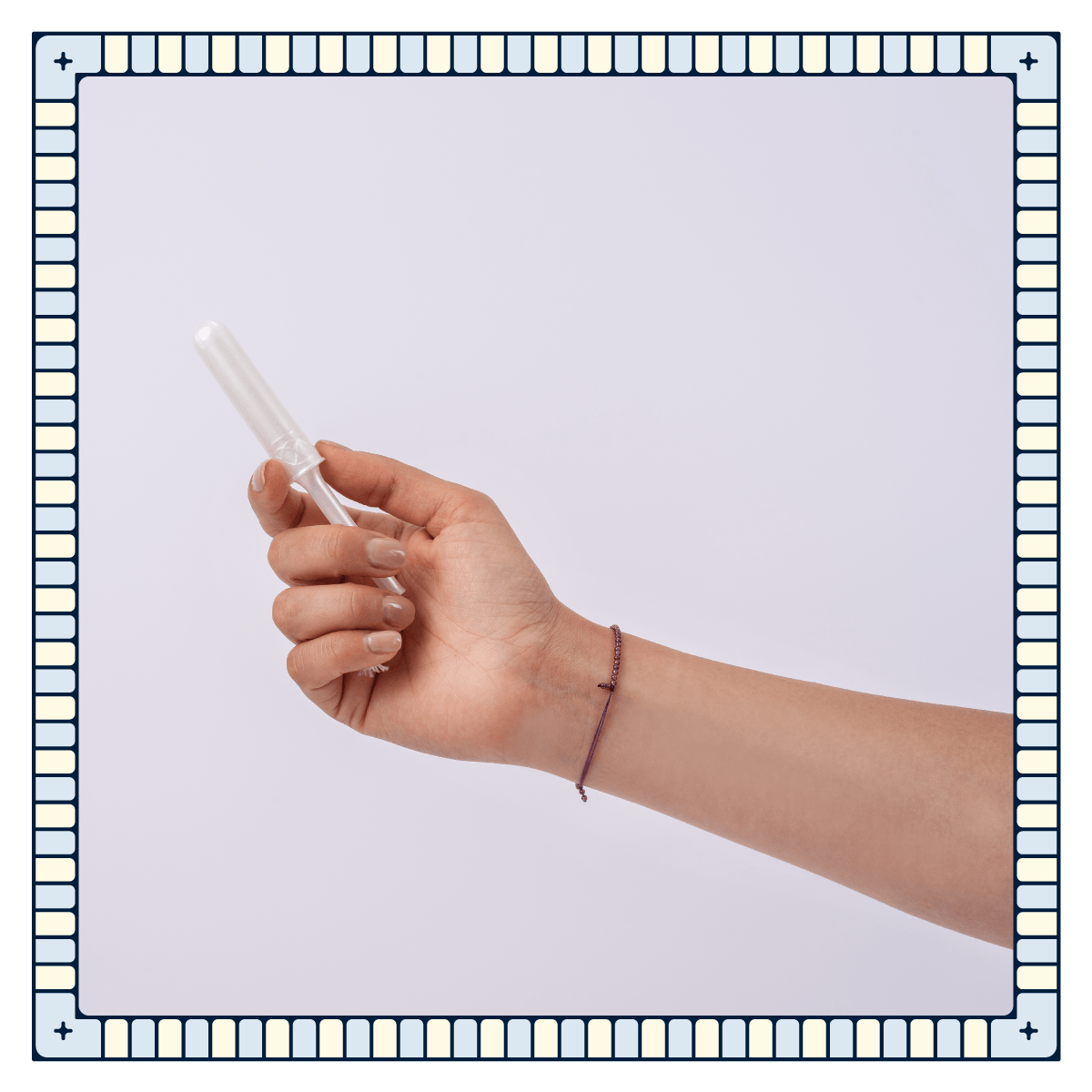Table of contents
1. Introduction
2. Sustainability and the Threat of Greenwashing
3. Navigating the Bioplastics Landscape
4. Making an Impact: The Importance of Properly Disposing Menstrual Products
5. Daye’s Tampon Applicator Material: Sustainability and Safety
6. More Questions, More Answers…
7. Wrapping it Up: Our Commitment to Sustainability and Continuous Improvement
8. Glossary
Written by Elena Provaggi
Illustrated by Maria Papazova
TLDR:
Sustainability in menstrual products is complex and often misunderstood. This white paper explores the truth behind bioplastics, debunks common sustainability myths, and explains why seemingly eco-friendly solutions like compostable tampon applicators aren't always the answer. We dive deep into Daye's material choices and commitment to genuine sustainability, helping you make informed decisions about your menstrual products while avoiding greenwashing traps.
Introduction
Did you know that over 28,000 tonnes of menstrual product waste are generated annually in the UK alone? With sustainability becoming a buzzword, how can we separate real solutions from greenwashing?
Sustainability is a critical topic that demands honesty and clarity. We believe that informed customers are empowered customers, equipped to make thoughtful decisions about the products they bring into their lives.
As demand for sustainable products grows, so does the risk of greenwashing. Terms like 'natural' or 'eco-friendly' can be misleading without clear evidence. We'll help you see through the marketing and understand the real impact of your choices.
At Daye, we take this process seriously, carefully considering each factor to ensure that our decisions are made with care for both the people and the planet.
This white paper dives into the reality of sustainable materials, focusing on tampon applicators to debunk myths about bioplastics and reveal often-overlooked truths. Our goal is to equip you with the knowledge to make informed decisions that genuinely benefit both your health and the environment.
Sustainability and the Threat of Greenwashing
Sustainable Materials: What Does It Really Mean?
Sustainability is about balancing environmental, social, and economic needs to meet today’s demands without compromising the ability of future generations to meet their own. Sustainable materials are those responsibly sourced, made with minimal environmental impact, and designed to be reused, recycled, or safely returned to nature.
The concept can feel vague because it is—there are so many variables at play. Hidden factors like energy-intensive production or transportation can offset the benefits of using renewable resources. To cut through this, tools like Life Cycle Assessment (LCA) offer the most reliable method, measuring environmental impacts like carbon footprint, water use, and emissions to provide the full picture.
Without clear definitions and measurable goals, sustainability risks becoming a buzzword, paving the way for greenwashing.
What is Greenwashing?
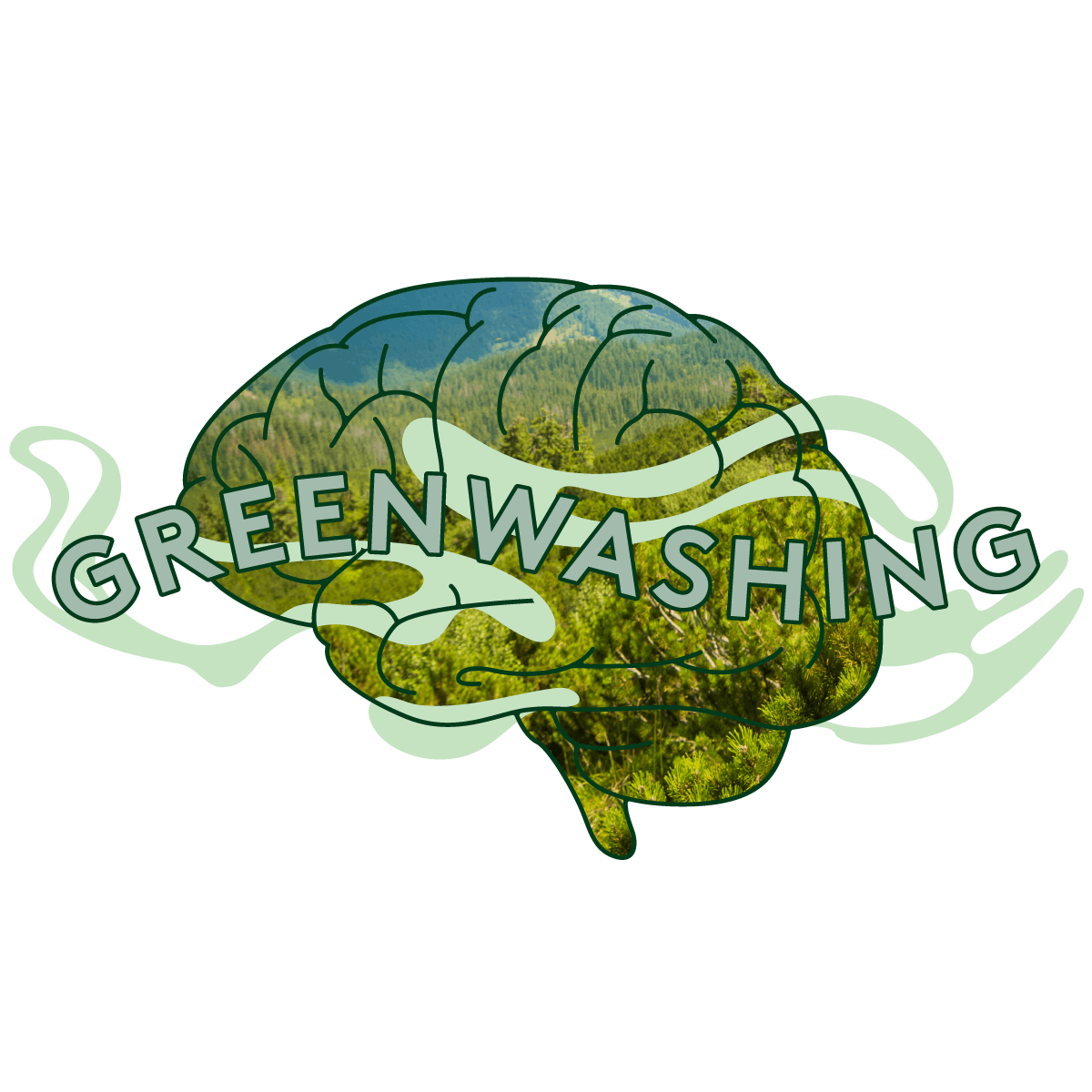
Greenwashing is the practice of conveying a false impression or providing misleading information about the environmental benefits of a company, product, or service. This tactic can make entities appear more environmentally friendly than they truly are, without necessarily reducing their actual environmental impact. The term was coined in the 1980s, but the practice itself backdates its formal definition.
Greenwashing can be either intentional or unintentional. Intentional greenwashing occurs when companies deliberately exaggerate or fabricate sustainability claims to attract environmentally conscious customers for the only real aim of increasing their profits. The intent is to deceive consumers into thinking they are making sustainable choices. Even when unintentional, greenwashing can occur when companies overestimate their environmental impact or lack a full understanding of their actions. This can still mislead consumers, creating a false sense of progress and hindering meaningful change.
Whether intentional or unintentional, greenwashing is harmful for several reasons. First, it perpetuates environmental harm by diverting attention from meaningful action. Second, it misleads consumers, giving them a false sense of contribution to sustainability, which can discourage further scrutiny or action.
To drive meaningful environmental progress, companies must substantiate their sustainability claims with verifiable, quantifiable actions that deliver measurable impacts, while maintaining transparency and honesty in their communications. At the same time, consumers have the power to drive change by actively questioning and holding brands accountable for their promises.
Navigating the Bioplastics Landscape
What are Bioplastics?
Conventional plastics, ubiquitous in packaging, clothing, and everyday products, pose significant environmental challenges due to pollution and reliance on fossil fuels. This has driven the search for better alternatives, like bioplastics.
Bioplastics are a type of plastic that can either be:
- Biobased: Made from renewable resources like plants (e.g., corn, sugarcane, or algae) instead of fossil fuels (coal, oil, and natural gas).
- Biodegradable: Designed to break down naturally under specific conditions by the action of microorganisms.
- Both: Some bioplastics tick both boxes—they’re biobased and biodegradable.¹
These traits don’t always go hand in hand. A biodegradable plastic might still largely rely on fossil fuels, or it could be biobased but not biodegradable.
Not all bioplastics are the same, and understanding the differences is key to assessing their potential environmental impact.
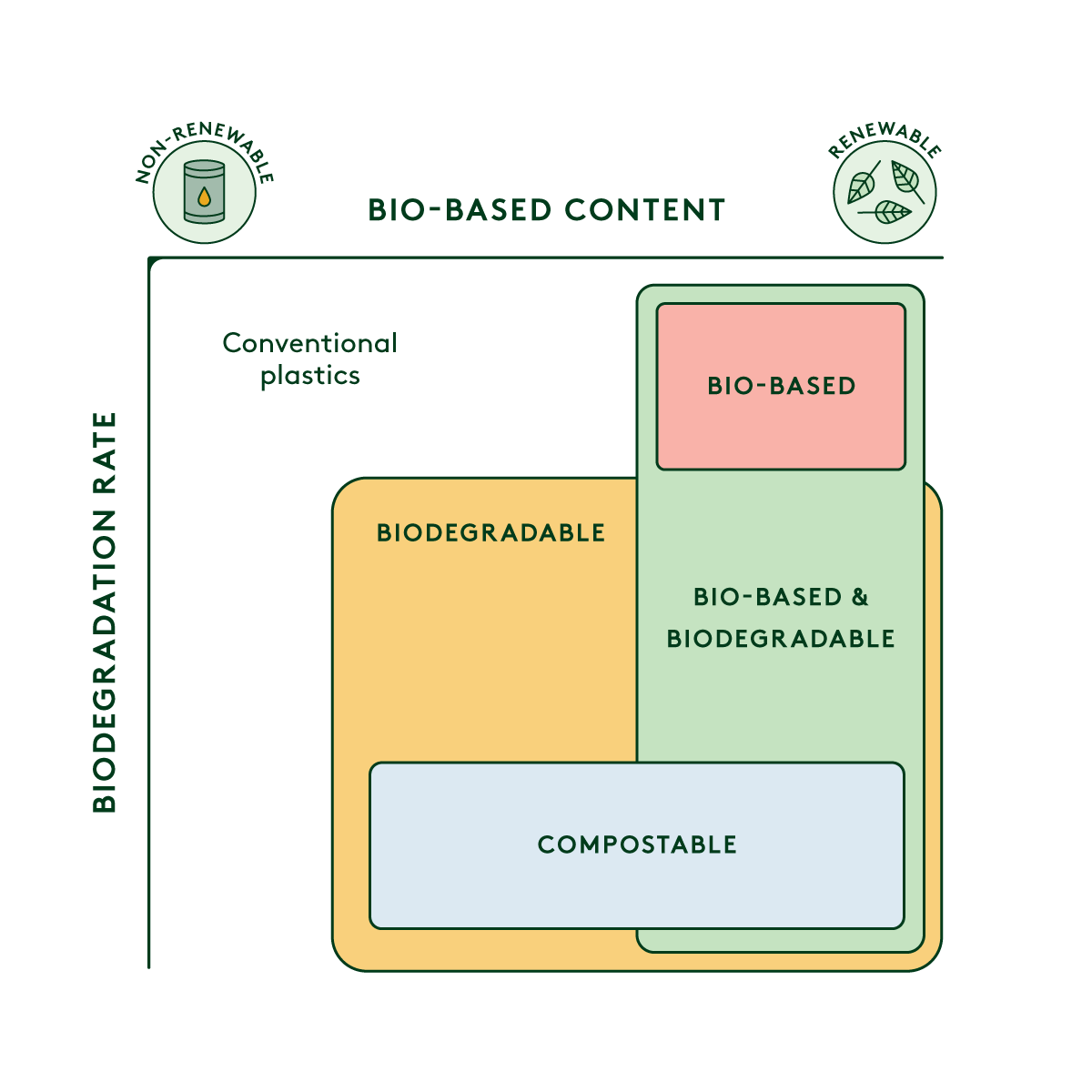
Debunking Misconceptions About Bioplastics
Let’s demystify bioplastics further. Below are common myths about bioplastics that help clarify some misunderstandings:
- Myth: Bioplastics are always better for the environment.
- Reality: The environmental impact of bioplastics depends on factors like sourcing, production, and disposal."
Bioplastics may have environmental benefits, but their full impact must be assessed, including disposal. Biobased plastics typically have a smaller carbon footprint than fossil-based plastics, but they still contribute to plastic waste and may pollute ecosystems if not disposed of properly. Biodegradable plastics cannot be recycled and only break down in specific environments.
- Myth: Biodegradable plastics degrade everywhere.
- Reality: Biodegradable plastics require specific conditions—oxygen, moisture, microorganisms, and appropriate temperatures—to decompose into CO2, H2O, and biomass.
Biodegradable plastics decompose into carbon dioxide (CO2), water (H2O) and biomass in environments that provide sufficient oxygen, moisture, microorganisms, and appropriate temperatures. Degradation is conditional—these conditions can be met in soil, but in the ocean, where the necessary microorganisms are absent, these materials can persist, release unwanted chemicals, and fragment into microplastics, contributing to pollution.
In anaerobic environments, such as landfills where oxygen is absent, organic materials—including biodegradable plastics—can decompose through processes that produce methane (CH4) as a byproduct. Methane is a potent greenhouse gas that can contribute to climate change if released into the atmosphere. Despite the EU Landfill Directive (1999/31/EC) aimed at reducing biodegradable waste in landfills, methane generation remains a concern.
- Myth: Biodegradable plastics degrade quickly.
- Reality: Biodegradability doesn’t equal rapid or safe degradation.
Did you know that biodegradability has no defined timeline? A material could take anywhere from a few months to several decades (or even longer) to fully degrade, and still be called biodegradable. While everything, including traditional fossil-based plastics, will eventually biodegrade, the process can take centuries.
This vagueness makes the term misleading and potentially meaningless, as it doesn’t guarantee rapid or environmentally safe degradation.

- Myth: Bioplastics are all natural.
- Reality: Bioplastics can contain more fossil than renewable content.
When something’s called biobased, you might assume it’s completely made from renewable materials—right? Wrong! Biobased plastics can still contain up to 80% fossil content! Similarly, biodegradable plastics may break down naturally, but they can still be made entirely from fossil fuels. Don’t be fooled—these terms don’t always mean what you think. Certifications like TÜV Austria's "OK Biobased" verify this proportion.
- Myth: Biodegradable always equals "more sustainable".
- Reality: Biodegradability only addresses end-of-life. True sustainability considers the entire lifecycle—sourcing, manufacturing, energy use, transportation, and disposal.
Biodegradable only means a material can break down, but this doesn’t guarantee it's environmentally harmless. While biodegradability focuses on the end-of-life stage, sustainability considers the entire lifecycle of a material. This includes sourcing, manufacturing, energy use, transportation, and disposal. A material that requires harmful chemicals or excessive energy to produce, it’s far from sustainable. Improperly discarded, they can still cause harm—left in nature or thrown in the ocean, they can persist for decades or longer.
- Myth: All biodegradable plastics are compostable.
- Reality: Only compostable materials break down fast enough to meet compostability criteria.
Biodegradability and compostability are often confused terms. While all compostable plastics are biodegradable, not all biodegradable plastics meet the criteria for compostability. Compostable materials must break down into non-toxic components within a specific timeframe (typically within 3-6 months) under controlled conditions and be turned into compost, while biodegradable materials may take longer to degrade and may leave harmful residues behind.
If a material is labelled biodegradable but not compostable, it means it cannot break down quickly enough to meet composting standards, whether at home or in specialised industrial facilities. This often happens because the material's degradation rate is much slower.
If biodegradable materials are not certified for composting, they should be disposed of in the general waste bin, as this is currently the most appropriate method for handling them.
To ensure proper disposal, always check with the manufacturer for clear instructions. Responsible labelling helps consumers make informed choices, reducing environmental impact.
- Myth: All compostable materials are equal.
- Reality: There is a big difference between home and industrially compostable materials.
First, a product labeled as compostable must have the appropriate certification—such as the “OK Compost HOME” or “OK Compost INDUSTRIAL” logo from TÜV Austria, or other recognised certifying bodies like BPI and DIN CERTCO.
- Home composting products are designed to break down in garden composting conditions (tested for ambient temperatures of 20°C to 30°C—even though many gardens experience lower temperatures) within 6 months. These products can be placed in home compost bins or collected through organic waste services, depending on local facilities.
- In contrast, industrial compostable products require sustained high temperatures (55°C to 60°C) in commercial facilities and must biodegrade within 12 weeks, so they should not be placed in home compost bins. Instead, they should be disposed of through organic waste collection services that send waste to industrial composting facilities.
Second, even within these categories, compostable materials vary widely—just like biodegradable ones. They can range from natural polymers like starch, cellulose, or seaweed, to bioplastics with varying bio-based content. This means that just because a material is compostable, it doesn't necessarily mean it is fully bio-based.
Compostability certification ensures materials break down into non-toxic components in a set time frame, but factors like composition can affect degradation, meaning it doesn’t guarantee breakdown in all environments. So, compostable materials are best disposed of as designed, composted!
- Myth: All degradable plastics biodegrade naturally.
- Reality: Some degradable plastics are not naturally biodegradable.
There’s a type of plastic that isn’t a biodegradable plastic but it can be mistaken for one. Oxo-degradable plastics are plastics designed to break down through oxidation, usually with added catalysts, but this isn’t true biodegradation as they are not being broken down by microbial activity. Research highlights uncertainties about their degradation timescales and microplastic persistence, particularly in different climates.² The European Union has banned oxo-degradable plastics due to their environmental concerns but they remain in use in some countries.
Making an Impact: The Importance of Properly Disposing Menstrual Products
Because of this, the importance of correct disposal cannot be overstated. Choosing sustainable products is a great start, but proper disposal is essential to minimizing the environmental impact of menstrual waste.
Are You Disposing of Single-Use Menstrual Products the Right Way?
Of those 26,903 tonnes of waste generated annually from disposable menstrual products in the UK alone, about 4% (3,363 tonnes) is estimated to be lost in the environment by flushing.³
Tampon applicators, like tampons, should never be flushed.

Never flush any menstrual product unless explicitly labeled as flushable—regardless of "biodegradable," "compostable," or "organic" claims. Compostable materials can block pipes and may not degrade properly in water. When in doubt, use the general waste bin.
When Disposed Of Correctly, Where Do They End Up?
Now let’s talk about where menstrual products ultimately end up. A staggering amount of menstrual items—tampons, pads, and applicators—end up in landfills and some get incinerated after use. When collected from public bins, they’re typically treated as contaminated waste and incinerated; whereas when disposed of at home in the general waste bin, they mostly go landfilled.
Landfills bury waste under layers, leading to slow, oxygen-deprived decomposition that can take years or even centuries.
Incineration, or thermal treatment, burns waste at high temperatures and can recover energy in some countries. Modern incinerators reduce emissions, but pollutants are still released, and the process has environmental trade-offs.

Why Compostable Applicators Are Unlikely a Solution
While seemingly ideal, compostable tampon applicators face significant challenges to being truly sustainable. Here's why:
First, most certification bodies and composting facilities don’t accept tampon applicators due to hygiene concerns, meaning they can’t be disposed of as intended—through composting. This raises a critical question: if a compostable product ends up in a landfill instead of being composted, is it still more sustainable than a non-compostable product?
A full Life Cycle Assessment (LCA) is the only way to definitively assess sustainability, comparing alternatives across their entire lifecycle: bio-based content, ethical sourcing, carbon footprint of manufacturing, transportation emissions, and actual disposal methods.
What we know is that compostable materials are designed to break down under specific conditions. However, when they end up in landfills, they decompose inefficiently due to being trapped between layers of waste without oxygen. This leads to two major issues. First, instead of breaking down into nutrient-rich compost, they generate not just CO₂ but methane (CH₄)—a greenhouse gas that is roughly 25 times more effective than CO₂ at trapping heat in the atmosphere. The EU has been trying to reduce biodegradable waste in landfills to address this methane issue for decades, but it remains a challenge!
Even when composted correctly, many 'compostable' products fail to break down as expected. A UCL study found that 60% of plastics labeled 'home compostable' don't break down in real-world conditions.
While compostable materials can be a sustainable solution when thoughtfully designed, properly processed, and disposed of in facilities that ensure actual composting, these conditions are rarely met in practice. As a result, a compostable tampon applicator is not a viable solution yet, as it cannot be effectively composted.
And When It Comes to Recycling?
Recycling also poses its own challenges with tampon applicators.
Despite our best efforts to make them recyclable, these items still face significant hurdles. While they can be made from recyclable materials and rinsed for recycling, the issue lies in their size. As an applicator is under 5cm in diameter, it can easily fall through sorting machinery in mixed recycling facilities (MRFs), even when placed in the recycling bin. As a result, despite being recyclable, these small items often end up in landfills or incinerators. Did you know this is one reason why the EU’s Tethered Caps Directive requires plastic caps to be attached to bottles? By keeping the bottle and cap together, the recycling process becomes easier, with fewer chances of the lids ending up in general waste.
Daye’s Tampon Applicator Material: Sustainability and Safety
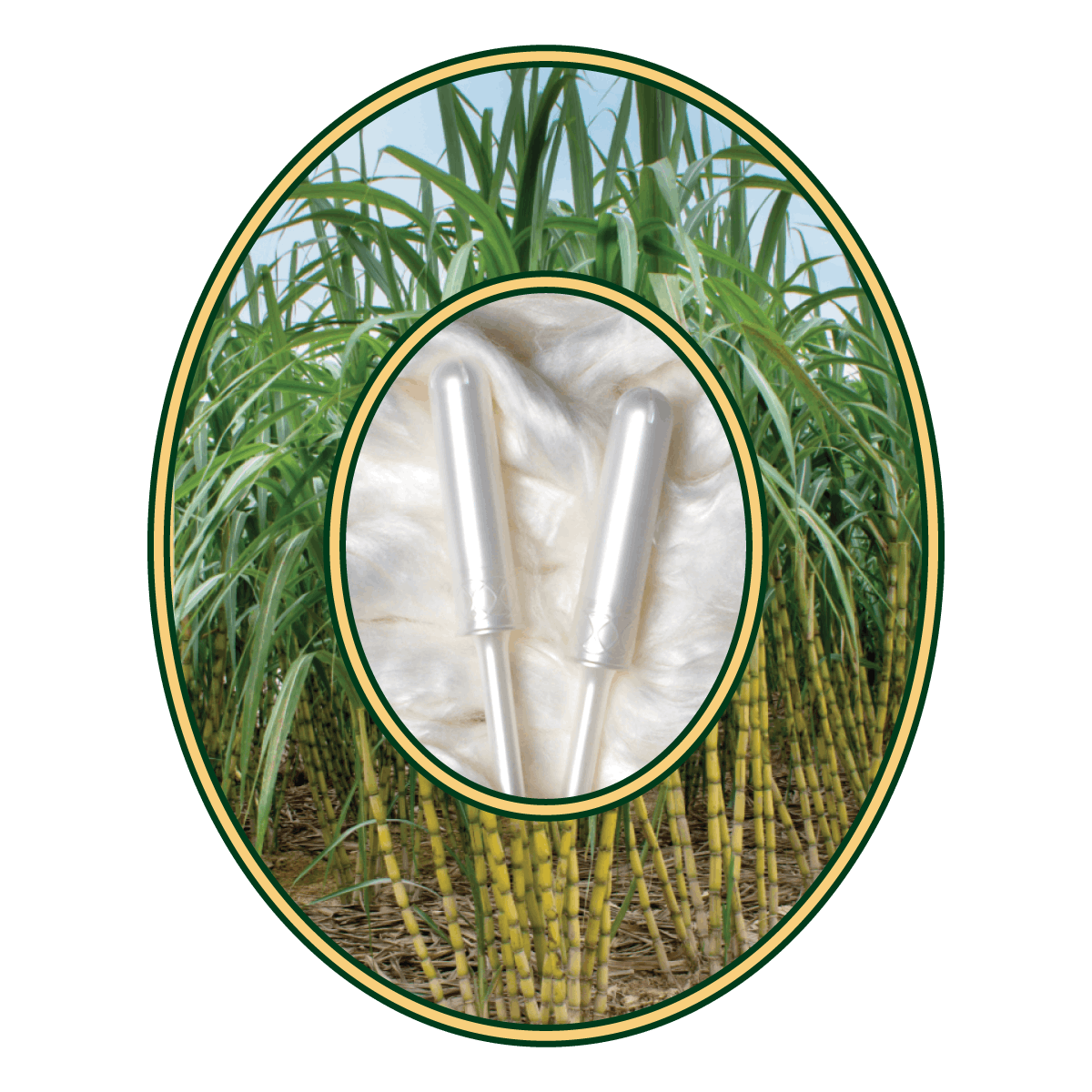
At Daye, sustainability is central to our product design, but we equally focus on ensuring that the safety, reliability, and performance of our products meet the highest standards.
Our rigorous testing process includes mechanical, durability, and biocompatibility tests to ensure our tampon applicators perform safely throughout their lifecycle. We thoroughly assess materials for their ability to be sanitised without degradation and ensure packaging durability. Only materials that meet these high standards are approved for use, as not all materials that sound sustainable are suitable for body contact applications.
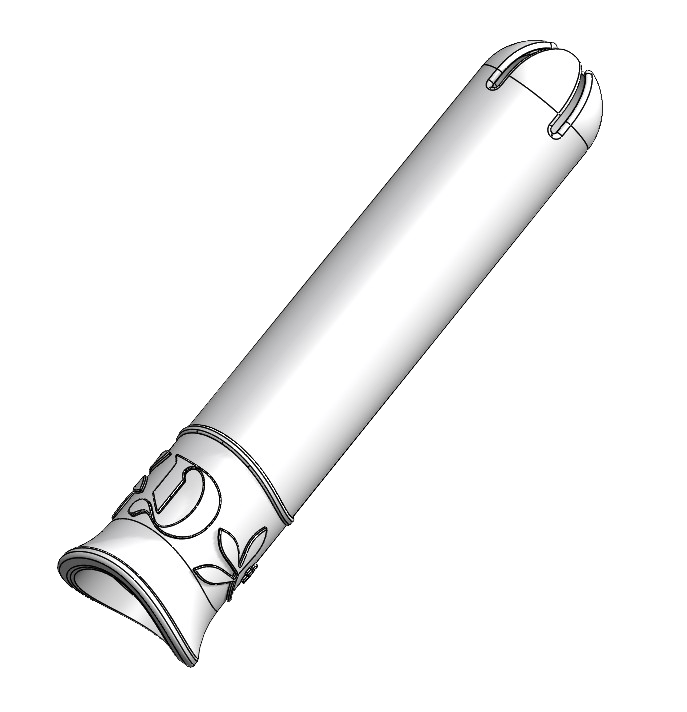
After thorough research and testing, we selected Braskem’s I’m Green™ bio-based LDPE for several key reasons:
- Renewable Resource: Unlike conventional plastics derived from fossil fuels, this material is produced from renewable sugarcane ethanol, ensuring a sustainable and responsible source. We utilise a material grade that is free from additives and boasts a minimum carbon biobased content of 95%.
- Carbon-Negative Production: I’m Green™ bio-based LDPE has a carbon-negative production process. For every kilogram of this material produced, 2.12 kilograms of CO₂ are removed from the atmosphere, making a measurable contribution to the reduction of carbon emissions.
- Recyclable: While recycling rates for small items like tampon applicators remain low, this material is recyclable. As recycling infrastructure improves, we’re committed to doing our part. To help, please rinse the applicator before recycling.
- Performance and Safety: Above all, tampon applicators must be reliable and safe to use. I’m Green™ bio-based LDPE offers the necessary durability, smoothness, and reliability required for comfort and performance, while offering a more sustainable alternative than traditional plastics.
More Questions, More Answers…
Why do we call our tampons biodegradable?
We use the term "biodegradable" because our tampons are made from GOTS-certified organic cotton, a natural material that will break down over time in natural environments. This is different from biodegradable plastics, which may contain fossil-derived materials that break down but can leave behind harmful residues. In contrast, our tampons are plastic-free, ensuring that they break down naturally, just as cotton fibers decompose in nature. It's important to note that while our tampons break down naturally, they are not compostable or flushable and should be disposed of in the general waste bin.

Are reusable menstrual products more sustainable than single-use options?
Reusable menstrual products, like menstrual cups and reusable pads, are generally more sustainable than single-use options. Life Cycle Assessments (LCAs) support the environmental benefits of menstrual cups, but they also show that sterilisation can significantly impact their sustainability profile.⁵,⁶ While raw materials have the highest impact for tampons and pads, the main environmental impact of menstrual cups comes from their use phase, especially the sterilisation process. For example, boiling the cup on a stove for 5 minutes after every use (instead of just washing with soap and water after every use and sterilising it once a month) may negate its environmental benefits due to the extra energy and resources required. The best-case scenario for a menstrual cup is a lifetime of at least 5 years.
That said, please follow the hygiene protocols carefully! A recent study showed that current hygiene practices for menstrual cups may fall short in preventing TSS and only one in five popular brands of menstrual cups met three out of five key recommendations for reducing TSS risk. Research indicates that the most effective cleaning method involves washing with soap and water, followed by steeping in boiled water for at least 5 minutes—this approach showed to eliminate Staphylococcus aureus, a bacteria associated with TSS.⁷ Additionally, if you choose a menstrual cup, opt for one without PFAs!
It's also important to note that menstrual cups are not currently regulated in the UK, meaning they are not classified as a medical device, so no safety testing is required. If menstrual cups are for you, make sure to choose a brand that conducts proper safety testing.
Does all this apply beyond tampon applicators and menstrual products?
Yes! The challenges and misconceptions around sustainability, biodegradability, and challenges around end-of-life disposal aren’t limited to tampon applicators and menstrual products. They extend to many other single-use products, like food and cosmetic packaging, coffee cups, straws, plastic cutlery, and so on. The key principles—evaluating a product’s full lifecycle, prioritising ethical sourcing, and ensuring proper disposal—apply to every industry. It’s about taking a holistic approach to sustainability, whether we’re talking about packaging, personal care items, or household goods. The focus should always be on understanding the environmental impact at every stage, from production to disposal.
How can I spot greenwashing?
Greenwashing can be tricky, so here’s how to spot misleading sustainability claims:
- Look for clear certifications: Trust recognised certifications like GOTS, TUV, or BPI for compostability. Don’t be afraid to scrutinise these claims!
- Demand transparency: Choose companies that are open about their product lifecycle—from sourcing all the way to disposal. Do they provide guidance on how to properly dispose of their product?
- Be cautious of vague claims: Words like “eco-friendly” or “natural” can sound great, but they mean little without real details to back them up. Always ask for specifics!
How can I take action beyond choosing sustainable products?
You can make a difference by educating yourself on proper disposal methods, supporting brands that prioritise transparency, advocating for better recycling and composting infrastructure, and reducing waste by buying less and embracing reusability and recyclability whenever possible.
Wrapping it Up: Our Commitment to Sustainability and Continuous Improvement
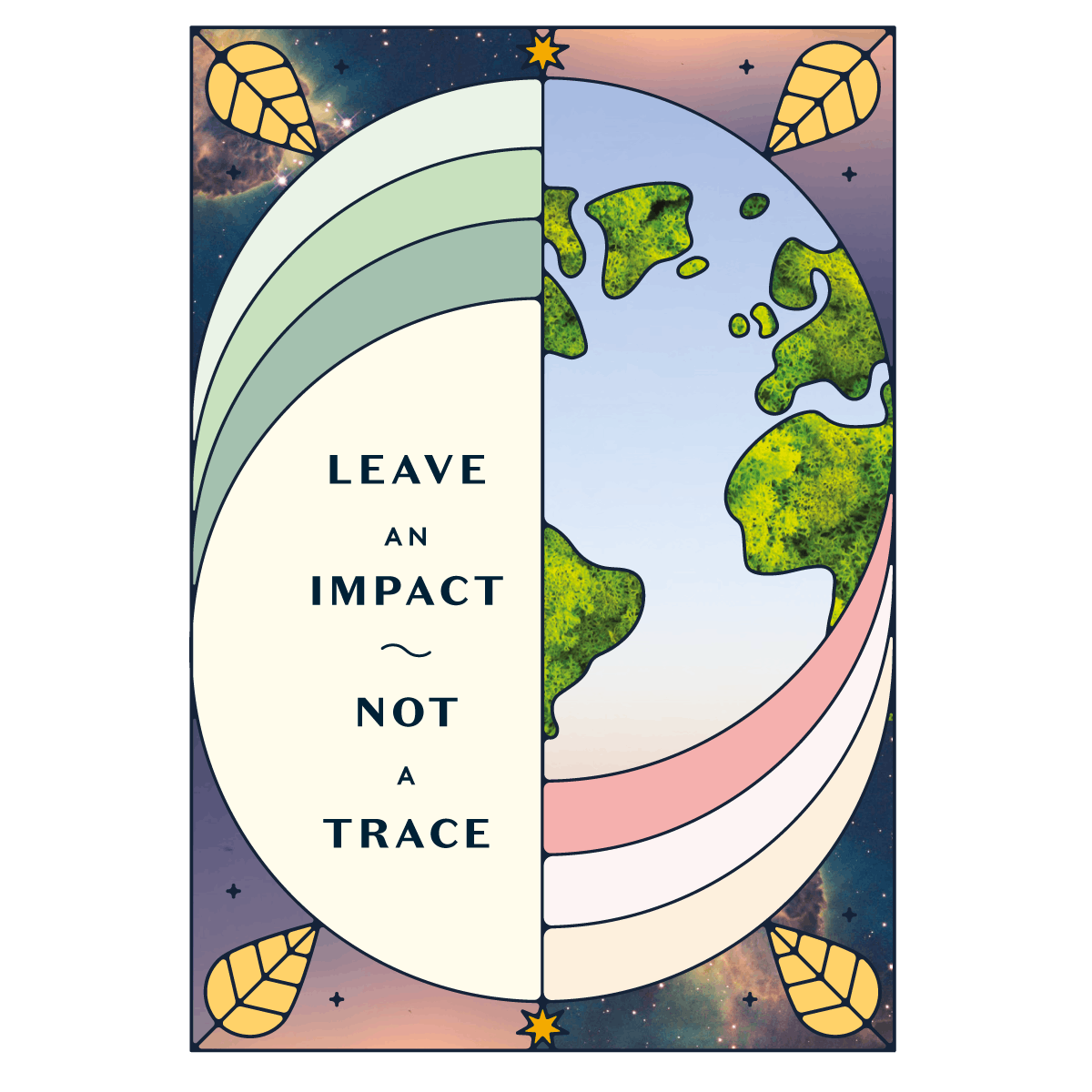
In a nutshell, greenwashing is often behind the scenes, and the most sustainable choice isn’t always the obvious one. Compostable applicators may not be the solution right now, but as infrastructure improves, there may be hope for new developments. Your choices do make a difference—every decision counts in shaping a more sustainable future.
Sustainability is a journey, and we’re on it, learning and evolving along the way. We are navigating a developing landscape and are committed to making the best choices with the information and resources available to us. At Daye, we believe in going beyond the minimum by not only choosing carbon-negative materials but also continuously working toward better solutions. From researching waste management systems to exploring alternatives like reusable applicators or applicator-free tampons, our goal is to improve both product performance and environmental impact.
If you're interested in learning more about how we continue to strive for sustainability in our products, please feel free to explore additional resources including How Daye Strives for Sustainability.
We invite you to question, challenge, and engage with what we share—don’t just take things at face value or settle for easy answers. True progress thrives on curiosity, meaningful dialogue, and a shared commitment to positive change. Let’s grow together, for the planet and for each other.
At Daye, we believe that every small choice can lead to big change. Together, let's challenge greenwashing, demand transparency, and make informed decisions that protect both our health and our planet.
Glossary
Biobased content
The proportion of a product derived from renewable biological resources, such as plants or animals, as opposed to fossil fuels.
Biodegradable
An object that can be broken down into natural elements (such as water, carbon dioxide, and biomass) by microorganisms in the environment, typically over a period of time.
Biomass
Organic material, typically from plants or animals, that can be used as a source of energy or as a raw material for various products.
Carbon Footprint
The total amount of carbon dioxide (CO2) emissions produced by human activity, typically measured in tons of CO2 per year.
Circular Economy
An economic system aimed at minimising waste and making the most of resources by reusing, repairing, refurbishing, and recycling products and materials.
Compostable
A material that breaks down into nutrient-rich organic matter under specific conditions (usually in a composting environment) without leaving harmful residues. It decomposes into non-toxic components in a relatively short period, typically within 3-6months.
Fossil Fuels
Non-renewable energy sources like coal, oil, and natural gas, formed over millions of years from ancient organic matter. Once consumed, they cannot be replaced and contribute to carbon emissions when burned.
GOTS (Global Organic Textile Standard)
A certification for organic textiles that ensures materials used are made from organically produced raw materials and produced under environmentally and socially responsible conditions.
Greewashing
The practice of companies making misleading or exaggerated claims about the environmental benefits of their products or practices. There are various types of greenwashing that companies can fall in.
Landfill
A landfill is a designated site where waste is buried, often under layers of soil. It is one of the most common methods of general waste disposal.
Recyclable
An object or material that can be collected, processed, and reused to make new products. However, not all materials are recyclable indefinetely—Aluminum, for example, can be recycled virtually infinitely without losing quality, while plastics degrade over time, making them less sustainable after multiple recycling cycles.
Renewable Resources
Natural resources that can replenish or regenerate over time, such as sunlight, wind, water, and plants. They are sustainable and can be used repeatedly without depleting the Earth's supply.
Sustainability
The ability to maintain or improve the quality of human life while minimising the impact on the environment and using resources in a way that does not compromise future generations ability to meet their needs. It encompasses environmental, social, and economic considerations. For more information, you can check the UN Sustainable Development Goals.
TSS (Toxic Shock Syndrome)
A rare but serious bacterial infection which can be associated with the use of internal menstrual products. Symptoms may include fever, low blood pressure, and rash, and it requires immediate medical attention.
Need more definitions or are curious about terms you haven’t heard before? Explore the EPA’s website on environmental topics and check out our article, Daye's Guide To Sustainability.
Referenced Studies
¹
Rosenboom JG et al. (2020)
Bioplastics for a circular economy. Nat Rev Mater. 2022;7(2):117-137. doi: 10.1038/s41578-021-00407-8. PMID: 35075395; PMCID: PMC8771173.
²
Sciscione F, Hailes HC, Miodownik M. (2023)
The performance and environmental impact of pro-oxidant additives containing plastics in the open unmanaged environment—a review of the evidence. R. Soc.Open Sci. 10: 230089.
³
Blair et al. (2022)
An exploratory study of the impact and potential of menstrual hygiene management waste in the UK. Cleaner Engineering and Technology. 2022; 7: 100435.
⁴
Purkiss et al. (2022)
The Big Compost Experiment: Using citizen science to assess the impact and effectiveness of biodegradable and compostable plastics in UK home composting. Frontiers in Sustainability; Volume 3 - 2022.
⁵
United Nations Environment Programme (2021)
Single-use menstrual products and their alternatives: recommendations from life cycle assessments.
⁶
Fourcassier et al. (2022)
Menstrual products: A comparable Life Cycle Assessment, Cleaner Environmental Systems, Volume 7, 100096, ISSN 2666-7894
⁷
Wunsch et al. (2022)
In Vitro Study to Assess Effective Cleaning Techniques for Removing Staphylococcus aureus from Menstrual Cups. Int J Environ Res Public Health. 2022 Jan 27;19(3):1450. doi: 10.3390/ijerph19031450. PMID: 35162481; PMCID: PMC8835062.


